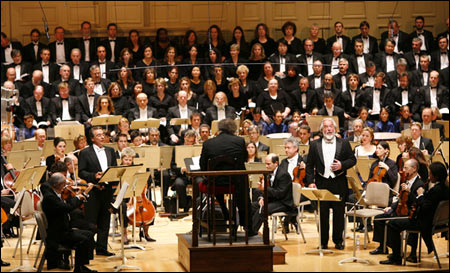
MOSES UND ARON: Think of Schoenberg as both brothers. |
Seventy-four years after Schoenberg composed (but never finished) Moses und Aron, 52 years after its first performance (Schoenberg didn’t live to hear it, even without the third act he originally intended), 40 years after its American premiere (by Sarah Caldwell’s Opera Company of Boston, at the old Back Bay Theatre), but only seven years after James Levine brought it to the Metropolitan Opera, this towering 20th-century masterwork got its first Boston Symphony Orchestra performance.
Schoenberg’s opera (or is it an oratorio?), which bumps theo-philosophical discourse up against Cecil B. DeMille orgy, will never achieve the popularity of a La bohème or a Faust — it doesn’t have enough (i.e., any) hummable tunes. But the music is so gripping, so quintessentially dramatic, I was surprised to see people leave before the performance was over. Levine, the orchestra, the Tanglewood Festival Chorus (in a rare performance in which the singers had to use scores), the PALS Children’s Chorus, and 17 vocal soloists sounded never less than 100 percent committed. It was a staggering achievement, a historic addition to the BSO repertoire.
I’ve seen two productions of Moses und Aron, but given the subject, it’s in some ways more appropriate to hear it in concert. For one thing, you can listen to the music undistracted. And the absence of stage images actually carries meaning. Schoenberg, who was soon to leave Germany in the increasing glare of a Nazi takeover and reconvert to Judaism, wrote his own libretto, turning the two Biblical brothers into philosophical polarities. Moses is the visionary whose God is invisible, an Idea, but he can’t articulate his vision of divine mystery. Aron (who as music theorist Allen Forte, quoted by BSO program essayist Joseph Auner, points out shares the first four letters, in this single-A spelling, with the composer’s first name) is the smooth talker who can transform the vision by reducing it to images that make it accessible to others (a congregation? an audience?).
Sarah Caldwell’s production opened with the profound image of Moses and Aron standing back-to-back in a circle of light, wearing identical costumes, as if they were two sides of the same personality — which I believe is what Schoenberg had in mind. The conflict between the two brothers may be less about monotheism than it is about art, maybe about Schoenberg’s own poignant inner conflict between dedicating himself to his vision of the possibilities of music — new, 12-tone music — and his desire to reach a larger audience. He is both Moses and Aron.
Schoenberg assigns to inarticulate Moses his old device of Sprechstimme, a kind of pitched declamation out of 19th-century melodrama, whereas Aron sings in suave melismas. The chorus bursts into industrial-strength furies and ecstasies but also whispers and unarticulated crowd noises (the 12-tone equivalent of “rhubarb rhubarb rhubarb”), and it even sings a waltz. Grand orchestral climaxes alternate with celestial, piquantly harmonized (xylophone, harps, celesta, and piano) chamber music. There are the mysteriously beautiful (beautiful!) passages Schoenberg wrote for the six voices embedded in the orchestra singing the words coming from the Burning Bush. And few moments in opera are more moving than the final hopeless words Moses speaks as the music dwindles to nothingness at the end of act two: “O Word, thou Word I cannot speak!”